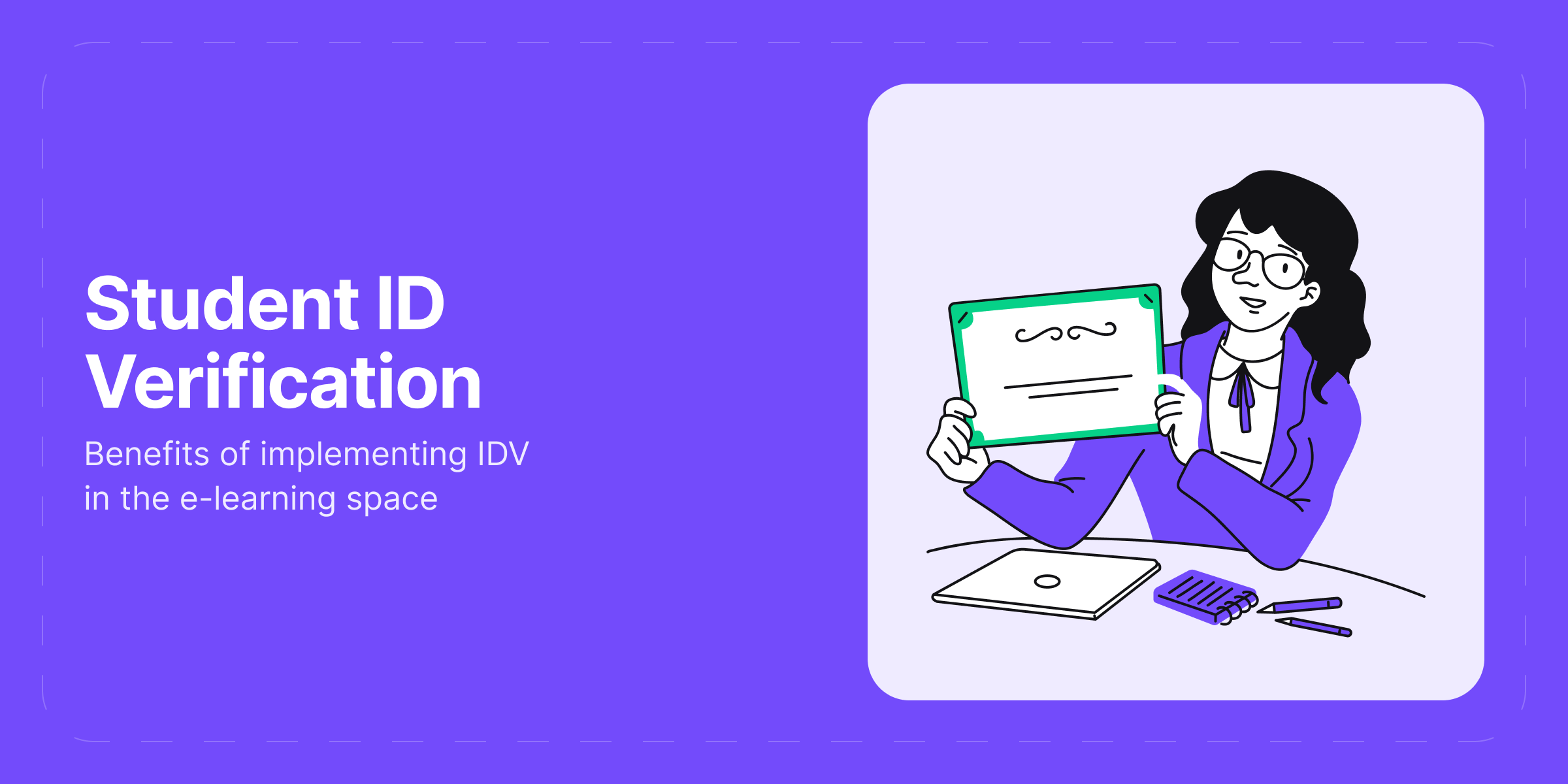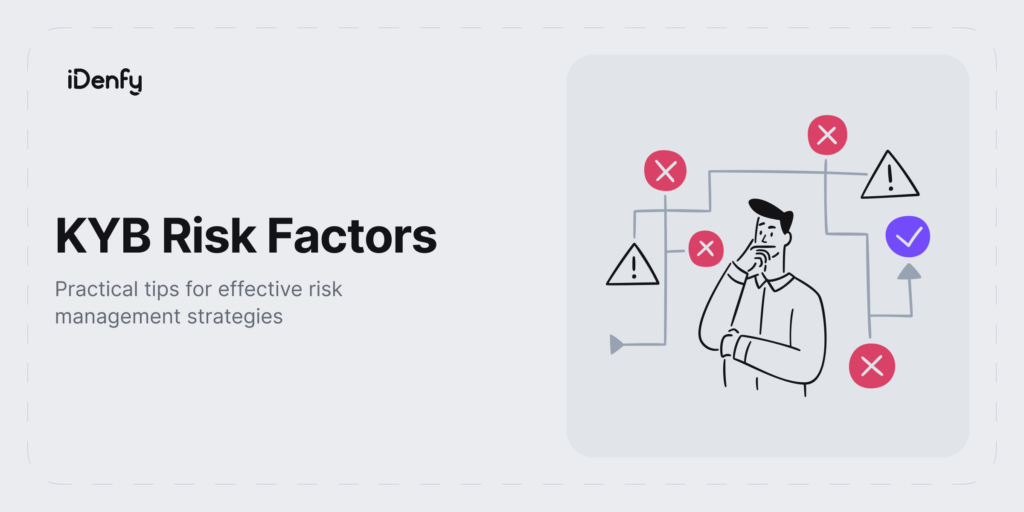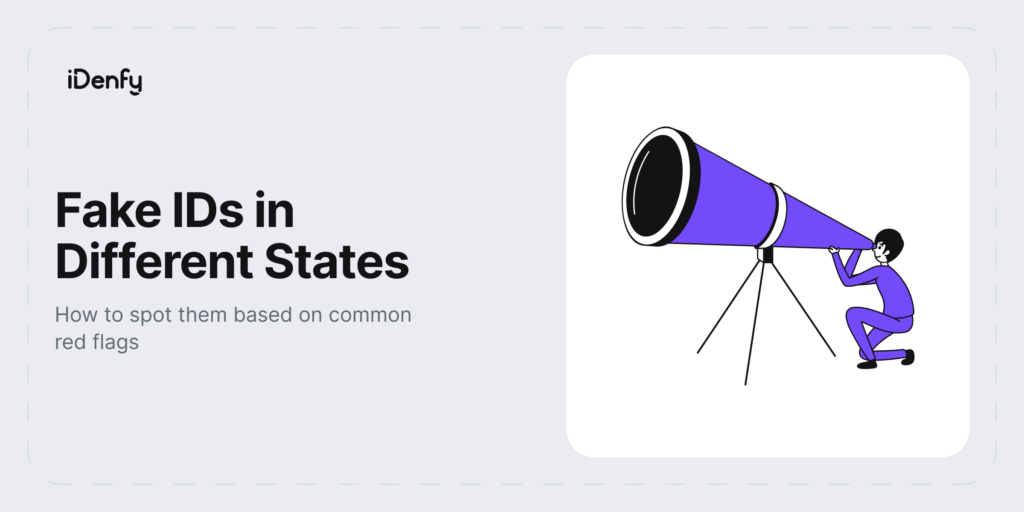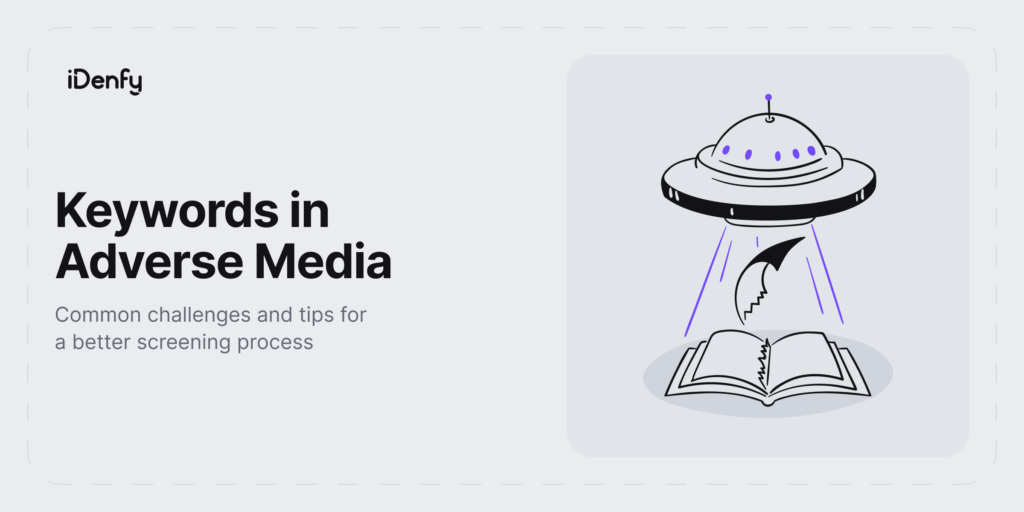With more e-learning apps to choose from and new remote university opportunities rising, the educational sector has shifted to a more convenient approach to learning. Partially, global events like the COVID-19 situation changed our habits for life, pushing boundaries in mobile banking and other spheres that we wouldn’t have imagined before.
And now, advancements like artificial intelligence have created both new workplaces and some security risks, but, more importantly, they’ve created new higher education programs for students to study fully online. Education institutions now need to contribute to the growth of the e-learning space by introducing convenient and compliant ways to accept new student registrations — which, naturally, requires a robust student identity verification process.
While remote studying is accepted, there are still loopholes and limitations in properly verifying students. Why? It’s simple. Like in many high-risk industries, banking, identity theft, and all sorts of fraudulent practices are still major issues. When it comes to online education, it’s the same principle. Some abuse student discounts, cheat on exams, or forge documents.
In this blog post, we’ll dig deeper into the e-learning trends and explain how identity verification can help the education industry solve security challenges.
The Definition of Student Identity Verification
Student identity verification is the process of assessing a learner’s identity in order to ensure that the student who registers for their classes or certificate is genuine, confirming their identity. In other words, this security measure helps ensure that the student who applied for their degree, for example, is the same student who completed their studies.
That said, student identity verification can be performed continuously throughout a student’s enrollment with the learning institution.
Here are some use-case examples showcasing the need for ID verification in the e-learning space:
- Before taking an exam in college or university
- Before enrolling in an institution or registering for an app
- For remote class attendance monitoring
- Before issuing diplomas or any other academic degrees
- Before taking applications for student loans or any sort of financial aid
What Does the Student Verification Process Look Like?
Before remote learning options became mainstream, traditional verification methods meant that students needed to be approved manually. This typically involved assessing students’ government-issued identity documents face-to-face with other faculty members. For example, before accessing on-campus resources, like books in libraries.
Today, student verification differs based on the type of learning institution the person has chosen. So, there are two main verification options: in-person ID verification and online student identity verification, which we discuss in more detail below.
1. In-Person Student Identity Verification
Students attending in-person colleges are required to verify their identities periodically. Traditionally, students taking exams are verified either by a campus administrator using a government-issued ID document. Additionally, students often need to scan or show their ID cards to access on-campus resources such as classroom buildings, libraries, and laboratories, as well as when taking important examinations.
Typically, educational institutions use personally identifiable information (PII) for identity verification. Examples include:
- Passport
- Driver’s license
- Birth certificate
- Social Security Number
- Student ID number
However, this approach can cause long waiting lines and frustration for many students. Additionally, the more people are waiting in line, the more chances for human error come in, heightening the possibility of accepting a fake document or a document that belongs to the wrong person.
2. Online Student Identity Verification
In recent years, an increasing number of students have leaned towards remote study programs. For example, the University of Birmingham offers 14 online courses, listing the benefit of “flexibility of online learning” as one of the biggest benefits, along with knowledge, skills and deep discussions. This shift eliminated borders and allowed more students to access education. However, this also means a greater potential for fraud.
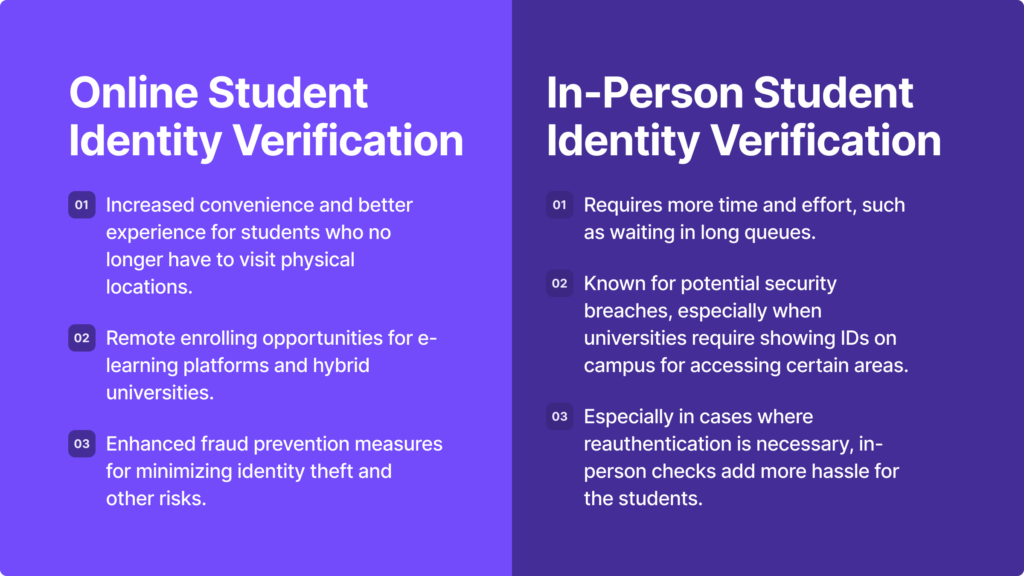
Some businesses in regulated industries like banking still use manual ID verification checks, including video interviews, when onboarding new customers. However, this practice can be costly and time-consuming, especially as competition increases. The same principle applies to e-learning platforms. Due to the error-prone and time-consuming nature of manual student ID verification, learning institutions are now adopting automated verification measures. This transition improves accuracy and efficiency, enhancing security and reducing inconsistencies.
Different Types of Student Identity Verification Measures
To provide the same level of security and convenience for online studies, universities and e-learning platforms use various student identity verification measures. Typically, they are used at the student’s account creation stage and at certain points during their education for reverification purposes.
We review each verification measure in a more detailed way below:
Selfie Verification
Students take a photo of their faces. The software often uses liveness detection technology to determine if the learner is present. Then, the system compares the selfie image with the photo of the person’s ID document to confirm their authenticity.
Government-Issued ID Verification
This is a similar process, except it requires students to take a photo of an ID document, like a passport or a driver’s license. For security reasons, this student verification method is paired with selfie checks or database checks. Platforms like Udemy as well as colleges, use this method to prevent fraud.
Student Email Verification
Students are typically assigned unique institution-specific email addresses to verify and confirm their student status, granting access to the email service. This is done by sending a one-time verification link that the student must activate from their inbox.
Account Verification
The student is directed to the university learning space, where they’re asked to log in. This verification measure ensures that the new account belongs to a specific student or e-learning platform’s user. After adding the correct credentials, the learner can access the space.
Reverification
Reverification is a process that involves verifying a student’s identity after the initial verification process to ensure accuracy and security. This type of verification safeguards against account takeovers and similar fraudulent behaviors by ensuring the student or the user on an e-learning platform and their personal data remain secure.
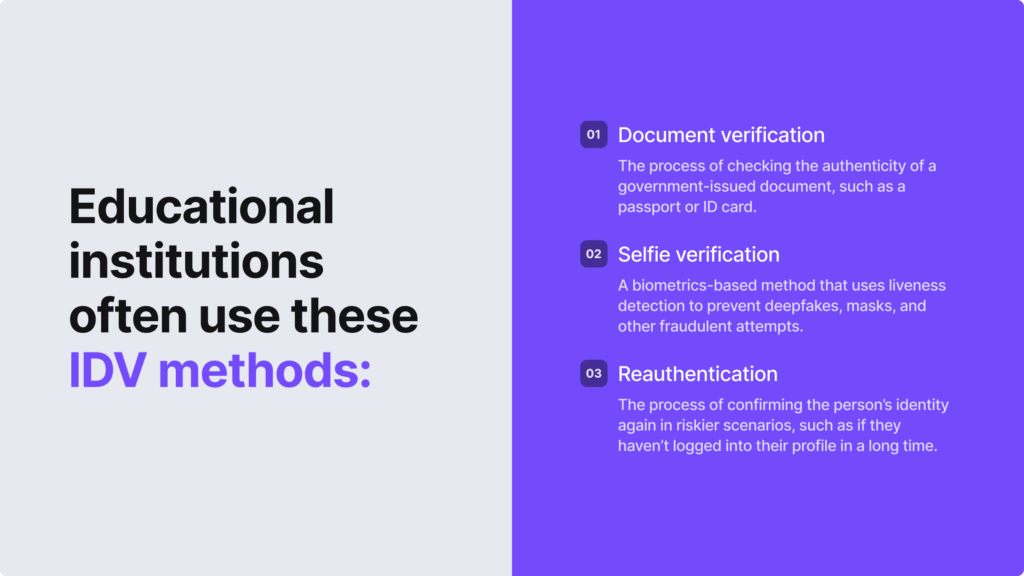
For instance, if a person’s ID document expires, or there’s a change in their surname, as well as if they haven’t logged into their student’s account in a long time, it’s a common practice to ask them to reverify their identity.
How Big of a Problem is Fraud in Education and E-Learning?
The e-learning environment is full of opportunities, helping students around the world to collaborate, save time, and gain skills without crossing any boundaries. However, both traditional schools and new online learning services have opened up new opportunities for fraudsters.
For example, there are cases of fake materials or deceptive promises on seemingly legitimate e-learning courses that offer fake certificates. At the same time, some students falsify documents to gain admission to colleges.
We look into some common fraud cases in more detail below.
Illegitimate Learning Sites
Criminals misuse the term “university” or “e-learning” by deceiving students into paying for educational services that do not actually exist. They may offer fake certificates and demand lower-than-usual payments for their studies.
Typically, legitimate platforms and learning sites have a support team and a structured system that doesn’t raise any red flags. In general, fake websites often use URLs that are similar but slightly different from legitimate ones, such as misspelling the institution’s name.
Related: How to Check if a Company is Legitimate
Student Visa Fraud
Some students from abroad commit student visa fraud, which can end them up with lost legal status to stay and study in the US, for example. The University of Farmington, established in 2015 in Michigan, was a fake university, also known as the “Paper Chase” operation. It was created by US Immigration and Customs Enforcement’s Homeland Security Investigations (HSI) to uncover student visa fraud in the US. It identified over 600 individuals caught up in this fraudulent act, leading to deportation for visa violations.
Another visa scam involving non-EU citizens purchasing fake documentation for Irish residence permits has also alarmed Dublin language schools. The scheme targeted foreign students, who agreed to pay for fake school enrollment letters to obtain Irish residence permits or study visas. Unfortunately, this scam has led to a significant drop in enrollments, forcing institutions to reduce fees and lay off staff. This has led to a sector-wide effort to prevent fraud and protect legitimate students, such as implementing more robust ID and document verification procedures.
Data Breaches
Learning institutions store a lot of sensitive data about their students and staff, making them prime targets for data breaches. Criminals use this stolen data to further execute their bad acts, such as impersonating a student or administrator to commit financial crimes. Currently, e-learning and education is the fifth most targeted industry for data breaches in the US, with over 1,600 publicly disclosed cyberattacks on schools in the last five years.
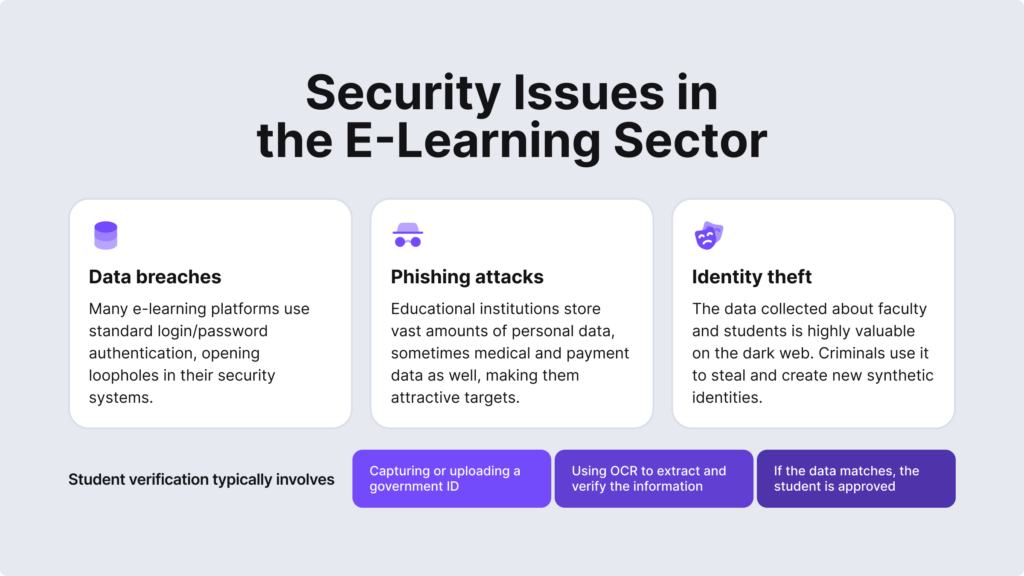
This doesn’t end here. In 2023, for example, thousands of files reportedly stolen from the Minnesota school district were published online after the school missed a $1 million ransom deadline set by a cyber gang. Partially, this happens due to the lack of measures, such as proper student identity verification procedures. Schools and online platforms often use standard login and password authentication, which is less secure than multi-factor authentication and other double-layer security practices.
Phishing Attacks
Deceptive emails that seem to be trustworthy sources are nothing new in the cybercriminal world. However, this is also a common practice to steal personal information in the education sector. Phishing emails usually include links or downloads that, when clicked, can infect systems or steal data. Once that’s done, account takeovers and data theft happen, allowing attackers access to students’ accounts.
The average school spends less than 8% of its IT budget on cybersecurity. That means that many learning institutions lack a cybersecurity incident response plan and are underprepared to face phishing attacks and other fraudulent schemes that fraudsters have been preparing. Using phishing, they can then steal sensitive information, distribute malware, send more fraudulent emails from compromised accounts, and launch additional attacks on the university’s network.
Why is Student Identity Verification Important?
Without any form of verification measures, students and staff risk getting involved in data breaches and unauthorized access. The education sector has a lot of valuable data that criminals want to use, but unfortunately, it’s not for educational purposes. In this sense, student ID verification is vital to improve the institution’s fraud prevention program and build trust.
Primarily, automated student identity verification helps the education sector solve these challenges:
- Detects fraud, such as forged documents like student visas.
- Verifies students and staff more accurately, reducing manual labor and onboarding costs.
- Improves the experience for students, helping them access their classes remotely.
- Adds an extra layer of security, minimizing the risks of account takeovers or data breaches.
With a dependable system, confirming whether the rightful student completed their studies and earned credit for them becomes easier. By integrating an automated verification system, learning institutions ensure that students complete course material fairly. In the meantime, staff can also rely on verified educational documents to avoid hiring unqualified candidates.
Finding a Trusted ID Verification Partner to Verify Your Students
Many factors, especially costs and limited resources, can put a barrier between a secure identity verification system and the institution. However, it is possible to manage both by ensuring a swift and seamless, fully digital identity verification process for students and learners worldwide, allowing them to conveniently access apps and other digital services.
But how can e-learning service providers and educational institutions choose the right verification providers? For starters, a reliable document database is essential, especially for educational services attracting multinational students or global apps that have a growing audience from various markets.
Ask yourself some important questions:
Does the solution offer a variety of integration options?
For example, a KYC flow is one in which users are sent a unique link to their verification session through a third party. Alternatively, you can embed the verification flow into your university’s website via a web SDK, keeping the process white-labeled to match your brand.
Does the solution carry both biometric and document verification options?
The process typically begins with the individual capturing or uploading their government ID. Next, Optical Character Recognition (OCR) technology extracts information from the document. Once the information matches, the student is verified and can proceed with enrollment at the institution.
iDenfy carries all these features, helping e-learning platforms and traditional educational institutions switch from a lengthy onboarding process to a simple ID verification flow, with the option to customize the process, reverify students, or accept other documents for address verification, and more. Interested in testing the solution for free? Let’s talk.
